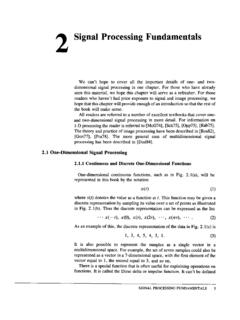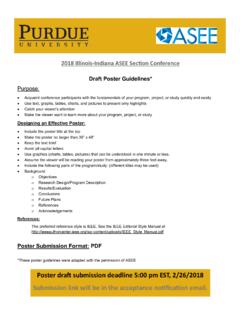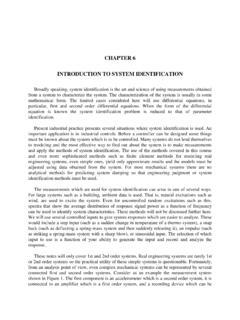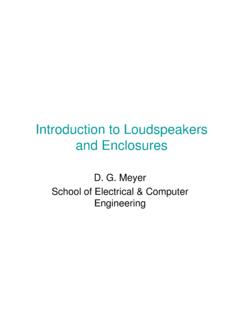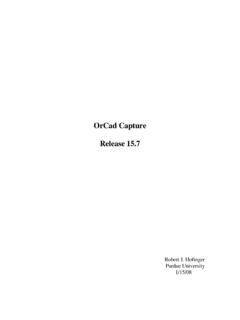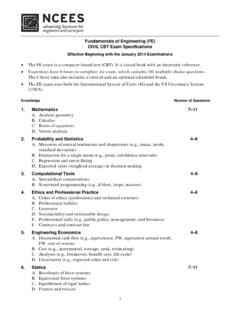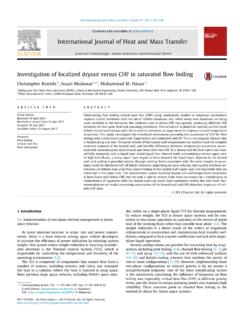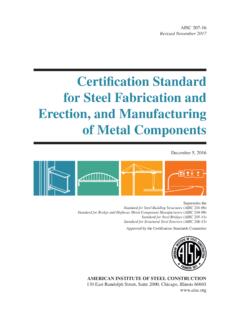Transcription of Intro to Structural Motion Control
1 Page 217 Thursday, July 11, 2002 4:33 PM. C H A P T E R 4. Tuned Mass Damper Systems INTRODUCTION. A tuned mass damper (TMD) is a device consisting of a mass, a spring, and a damper that is attached to a structure in order to reduce the dynamic response of the structure. The frequency of the damper is tuned to a particular Structural frequency so that when that frequency is excited, the damper will resonate out of phase with the Structural Motion . Energy is dissipated by the damper inertia force acting on the structure. The TMD concept was first applied by Frahm in 1909 (Frahm, 1909) to reduce the rolling Motion of ships as well as ship hull vibrations. A theory for the TMD was presented later in the paper by Ormondroyd and Den Hartog (1928), followed by a detailed discussion of optimal tuning and damping parameters in Den Hartog's book on mechanical vibrations (1940).
2 The initial theory was applicable for an undamped SDOF system subjected to a sinusoidal force excitation. Extension of the theory to damped SDOF systems has been investigated by numerous researchers. Significant contributions were made by Randall et al. (1981), Warburton (1981, 1982), Warburton and Ayorinde (1980), and Tsai and Lin (1993). This chapter starts with an introductory example of a TMD design and a brief description of some of the implementations of tuned mass dampers in building structures. A rigorous theory of tuned mass dampers for SDOF systems subjected to harmonic force excitation and harmonic ground Motion is discussed next. Vari- ous cases, including an undamped TMD attached to an undamped SDOF system, a damped TMD attached to an undamped SDOF system, and a damped TMD.
3 Attached to a damped SDOF system, are considered. Time history responses for a 217. Page 218 Thursday, July 11, 2002 4:33 PM. 218 Chapter 4 Tuned Mass Damper Systems range of SDOF systems connected to optimally tuned TMD and subjected to har- monic and seismic excitations are presented. The theory is then extended to MDOF. systems, where the TMD is used to dampen out the vibrations of a specific mode. An assessment of the optimal placement locations of TMDs in building structures is included. Numerous examples are provided to illustrate the level of Control that can be achieved with such passive devices for both harmonic and seismic excitations. AN INTRODUCTORY EXAMPLE. In this section, the concept of the tuned mass damper is illustrated using the two- mass system shown in Figure Here, the subscript d refers to the tuned mass damper; the structure is idealized as a single degree of freedom system.
4 Introducing the following notation 2 k = ----- ( ). m c = 2 m ( ). 2 k d = ------d- ( ). md c d = 2 d d m d ( ). and defining m as the mass ratio, m m = ------d- ( ). m the governing equations of Motion are given by 2 p . Primary mass ( 1 + m )u + 2 u + u = ----- mu d ( ). m p k kd m md c cd u u 1 ud FIGURE : SDOF-TMD system. Page 219 Thursday, July 11, 2002 4:33 PM. Section An Introductory Example 219. 2 . Tuned mass u d + 2 d d u d + d u d = u ( ). The purpose of adding the mass damper is to limit the Motion of the structure when it is subjected to a particular excitation. The design of the mass damper involves specifying the mass md , stiffness kd , and damping coefficient cd . The optimal choice of these quantities is discussed in Section In this example, the near-optimal approximation for the frequency of the damper, d = ( ).
5 Is used to illustrate the design procedure. The stiffnesses for this frequency combi- nation are related by k d = mk ( ). Equation ( ) corresponds to tuning the damper to the fundamental period of the structure. Considering a periodic excitation, p = p sin t ( ). the response is given by u = u sin ( t + 1 ) ( ). u d = u d sin ( t + 1 + 2 ) ( ). where u and denote the displacement amplitude and phase shift, respectively. The critical loading scenario is the resonant condition, = . The solution for this case has the following form: p 1. u = -------- --------------------------------------2- ( ). km 1 + 2 1. - + -------- . ----- m 2 d 1. u d = --------u ( ). 2 d 2 1. tan 1 = ------ + -------- ( ). m 2 d . tan 2 = --- ( ). 2. Page 220 Thursday, July 11, 2002 4:33 PM. 220 Chapter 4 Tuned Mass Damper Systems Note that the response of the tuned mass is 90 out of phase with the response of the primary mass.
6 This difference in phase produces the energy dissipation contributed by the damper inertia force. The response for no damper is given by p 1. u = --- ------ ( ). k 2 .. 1 = --- ( ). 2 . To compare these two cases, we express Eq. ( ) in terms of an equivalent damping ratio: p 1. u = --- -------- ( ). k 2 e . where m 2 1 2. e = ----- 1 + ------ + -------- ( ). 2 m 2 d . Equation ( ) shows the relative contribution of the damper parameters to the total damping. Increasing the mass ratio magnifies the damping. However, since the added mass also increases, there is a practical limit on m. Decreasing the damping coefficient for the damper also increases the damping. Noting Eq. ( ), the rela- tive displacement also increases in this case, and just as for the mass, there is a prac- tical limit on the relative Motion of the damper.
7 Selecting the final design requires a compromise between these two constraints. Example : Preliminary design of a TMD for a SDOF system Suppose = 0 and we want to add a tuned mass damper such that the equivalent damping ratio is 10%. Using Eq. ( ), and setting e = , the following relation between m and d is obtained: m 2 1 2. ----- 1 + ------ + -------- = (1). 2 m 2 d . The relative displacement constraint is given by Eq. ( ): 1. u d = -------- u (2). 2 d . Page 221 Thursday, July 11, 2002 4:33 PM. Section An Introductory Example 221. Combining Eq. (1) and Eq. (2) and setting = 0 leads to 2. m u d ----- 1 + ----- = (3). 2 u . Usually, u d is taken to be an order of magnitude greater than u . In this case, Eq. (3). can be approximated as m u d . ----- ----- (4). 2 u.
8 The generalized form of Eq. (4) follows from Eq. ( ): 1. m 2 e ------------- (5). u d u . Finally, taking u d = 10u yields an estimate for m: 2 ( ). m = --------------- = (6). 10. This magnitude is typical for m. The other parameters are 1 u . d = --- ----- = (7). 2 u d . and from Eq. ( ). k d = mk = (8). It is important to note that with the addition of only 2% of the primary mass, we obtain an effective damping ratio of 10%. The negative aspect is the large rela- tive Motion of the damper mass; in this case, 10 times the displacement of the pri- mary mass. How to accommodate this Motion in an actual structure is an important design consideration. A description of some applications of tuned mass dampers to building struc- tures is presented in the following section to provide additional background on this type of device prior to entering into a detailed discussion of the underlying theory.
9 Page 222 Thursday, July 11, 2002 4:33 PM. 222 Chapter 4 Tuned Mass Damper Systems EXAMPLES OF EXISTING TUNED MASS DAMPER SYSTEMS. Although the majority of applications have been for mechanical systems, tuned mass dampers have been used to improve the response of building structures under wind excitation. A short description of the various types of dampers and several building structures that contain tuned mass dampers follows. Translational Tuned Mass Dampers Figure illustrates the typical configuration of a unidirectional translational tuned mass damper. The mass rests on bearings that function as rollers and allow the mass to translate laterally relative to the floor. Springs and dampers are inserted between the mass and the adjacent vertical support members, which transmit the lateral out-of-phase force to the floor level and then into the Structural frame.
10 Bidirectional translational dampers are configured with springs/dampers in two orthogonal directions and provide the capability for controlling Structural Motion in two orthogonal planes. Some examples of early versions of this type of damper are described next. John Hancock Tower (Engineering News Record, Oct. 1975). Two dampers were added to the 60-story John Hancock Tower in Boston to reduce the response to wind gust loading. The dampers are placed at opposite ends of the fifty-eighth story, 67 m apart, and move to counteract sway as well as twisting due to the shape of the building. Each damper weighs 2700 kN and consists of a lead-filled steel box about m square and 1 m deep that rides on a 9-m-long steel plate. The lead-filled weight, laterally restrained by stiff springs anchored to the interior col- umns of the building and controlled by servo-hydraulic cylinders, slides back and forth on a hydrostatic bearing consisting of a thin layer of oil forced through holes in the steel plate.
